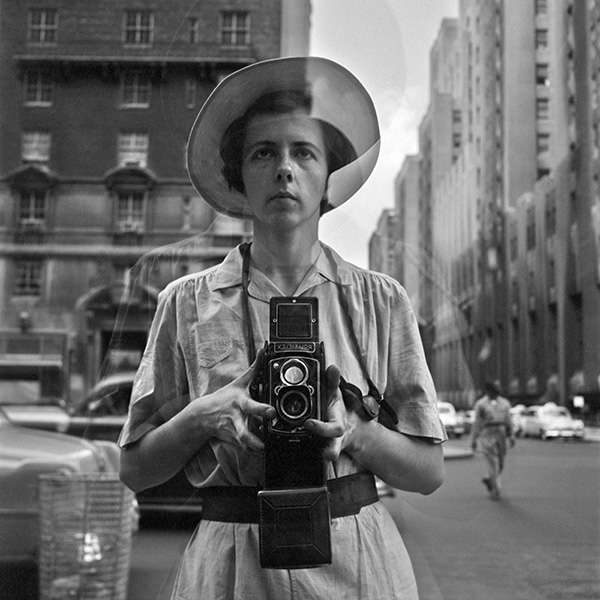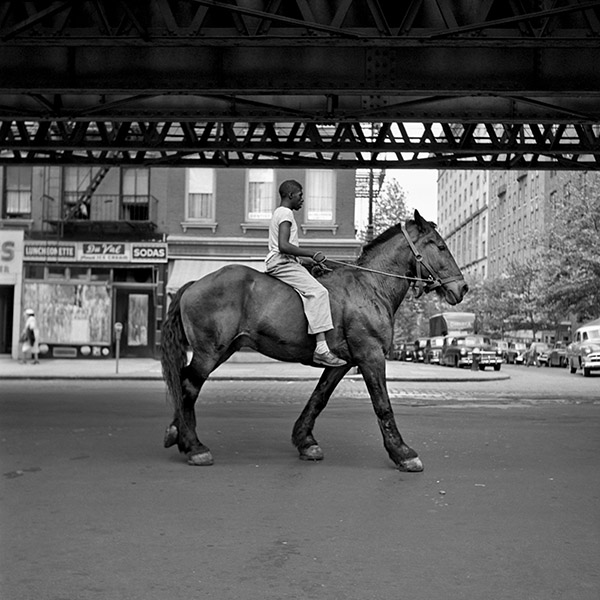Vivian Maier (1926 – 2009)
American Photographer
With a body of work spanning more than four decades, Vivian Maier (1926 – 2009) is one of the most prolific and distinctive American photographers of the mid to late twentieth century. Despite the recent popularity of her work, however, her life remains shrouded in mystery. An enigmatic figure, she lived in relative obscurity not far from her birthplace of The Bronx, New York, spending the majority of her career working as a nanny in the suburbs of Chicago and remaining there until her death in Oak Park, Illinois, at the age of 83. While she made no attempt to showcase her photographs during her lifetime, they have attracted widespread interest and critical acclaim posthumously. It is perhaps the accessibility of her work which most appeals; combining precise yet subtle artistic invention with an astonishing variety of subjects – most prevalently, scenes of urban life – her work symbolises harmonious accord between aesthetics and narrative.
Piecing together Vivian’s life story since her death in 2009 has become the collaborative enterprise of a few dedicated proponents of her work such as Ann Marks, John Maloof, and Jeffrey Goldstein; the latter two were among the first to acquire Vivian’s effects when they were auctioned, two years before her death, to cover debts she had accrued. According to insights recovered by Ann’s research, Vivian’s upbringing was tempestuous. Born to a French mother and Austrian father, Vivian’s parents separated in 1927. As well as periods of habitation in the U.S., she spent six years of her childhood and a portion of her early 20s living in France. For a brief period in the early 1930s, census records reveal that Vivian and her mother spent time living with French photographer and sculptor Jeanne Bertrand, who may have been one of Vivian’s early creative influences.
Vivian purchased her first camera using inheritance bequeathed to her by her maternal grandmother, Eugenia Jaussaud; she would later be omitted from the wills of both of her parents. She began experimenting with photography during a trip to her ancestral home in France, continuing to record her travels across Los Angeles, Manila, Bangkok, Shanghai, Beijing, India, Syria, Egypt and Italy during an ambitious world tour in 1959 and 1960. Vivian eventually settled in Chicago’s North Shore area in 1956. It was here that she would work as a nanny and carer for the next forty years, looking after the children of various households and also briefly working as a housekeeper. According to her peers, Vivian was capricious and intensely private; while some of the children in her care later described her as severe, others remember her as an adventurous, lively person who was determined to broaden their horizons and education. When Vivian fell into poverty towards the end of her life, three of the children she had cared for financed her accommodation and care.
At the residences of her employers, Vivian kept a myriad of documentary materials including boxes of negatives, piles of newspapers, and audio recordings of conversations she had with the people she photographed. Thousands of these negatives remained undeveloped until her death. Cumulatively, Vivian’s creative output indicates her interest in the process, rather than the result, of her photography; despite generating vast quantities of work, she refused to show her images to others. Frequently featuring her own shadow, her photography suggests her satisfaction in being free to wander, to intuit, and to observe; however, while the overall impression is one of detachment and independence, her work equally reveals the empathy she felt for her subjects.
Vivian’s work was initially uncovered in 2007 when John Maloof, an estate agent and amateur historian, purchased a non-descript box of photographic materials at an auction in Chicago. Captivated by her work and inscrutable character, John is now spearheading efforts to archive and catalogue Vivian’s expansive oeuvre. The retrospective development and exhibition of her work has raised questions regarding ethics and legal ownership, but consensus emphasises the importance of preserving and illuminating Vivian’s legacy. As the public profile of her work continues to proliferate, so too does the impact of her singular and uncompromising vision upon the contemporary photographic canon.
all images © Vivian Maier, Courtesy of Maloof Collection and Howard Greenberg Gallery, NY.















